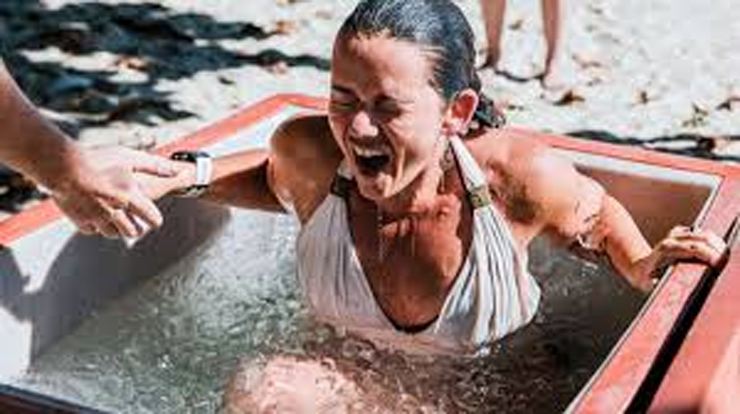
Cold plunges are making waves in the wellness community, with celebrities from Hollywood to K-pop embracing the trend. BLACKPINK's Jennie, known for her captivating performances and energetic dance moves, recently shared how this practice has become a staple in her wellness routine. At 28, Jennie revealed that cold plunging helps her unwind, improve physical recovery, and boost her mental resilience, but does this icy ritual really live up to the hype?
Table of Content:-
Jennie’s Journey with Cold Plunges: A Cultural Practice
In a recent interview, Jennie explained how the sauna and cold plunge culture in South Korea influenced her wellness habits. “The sauna is really big in South Korea,” she said. “I’d go every day, and the cold plunge right after was a natural thing for me.” She recalled how her first experience with cold plunging brought immediate relief from muscle soreness and tension, adding that it surprised her with an instant lift in her mood. This routine has since become a ritual for Jennie, who now uses cold plunges as a way to refresh both her mind and body.
Jennie likens the practice to hitting a “reset button” each day. Setting a timer for 2 minutes and 20 seconds, she challenges herself to endure the chill a little longer each day, seeing the ritual as a personal test of mental and physical toughness. Jennie noted, “Gradually, your body learns to deal with the cold, and you feel proud of yourself.” This consistent effort has helped her strengthen her mental resilience, making her feel ready to tackle both professional and personal challenges with renewed energy.
View this post on Instagram
Cold Plunges: Physical and Psychological Benefits
While Jennie swears by cold plunges for reducing soreness and boosting energy, what does science say about the effects of this frosty practice? Studies suggest that cold plunges can be beneficial, particularly in reducing inflammation, improving blood circulation, and relieving muscle tension. Cold water therapy, according to a 2018 study published by the National Center for Biotechnology Information, has been shown to lower inflammation markers, helping people recover faster from physical exertion. Additionally, a study in 2015 suggested that ice baths lasting between 11 to 15 minutes may enhance the body’s natural recovery process.
When cold water hits the skin, blood vessels constrict, pushing blood away from the surface and stimulating circulation once the body warms back up. This effect can help alleviate muscle pain and improve recovery after physical activity, making it particularly valuable for performers like Jennie who are on their feet for long hours. Moreover, cold plunging activates the body’s “fight or flight” response, leading to a surge of endorphins that can help reduce stress and create a sense of euphoria post-dip.

Mental Resilience Through Cold Plunging
For Jennie, cold plunging isn’t only about physical recovery but also about building mental resilience. Each time she faces the challenge of withstanding icy temperatures, she strengthens her mental resolve, which she believes translates to other areas of her life. “It taught me to embrace tension and push through challenges,” she shared. By voluntarily exposing herself to the discomfort of cold water, Jennie trains her mind to stay calm and persistent in difficult situations. This sense of accomplishment and self-belief, she adds, leaves her feeling “tougher than I think I am.”
Also Read: Australia Bans Social Media for Under-16s: Exploring the Harmful Effects on Young Minds
Potential Risks and Safety Measures
Despite its benefits, cold plunging is not without risks, and safety should always come first. For individuals new to cold-water exposure, jumping in too quickly or staying submerged for too long can be dangerous. Abrupt exposure to extreme cold can lead to issues with heart rate, and blood pressure, or even cause hyperventilation. WebMD notes that prolonged exposure to icy water can lower the body’s temperature to a dangerous level, leading to hypothermia or frostbite, particularly in colder climates.
To mitigate these risks, experts recommend starting slowly, perhaps with a quick dip in cool—not freezing—water, gradually building up endurance. Beginners should also limit their immersion time and avoid plunging into cold water alone to ensure safety. As Jennie does, setting a timer and listening to your body’s cues can be a good way to ease into practice without overextending your limits.
Cold Plunges: Just a Trend or Here to Stay?
Jennie’s commitment to cold plunging highlights a growing trend, but it also showcases a balanced approach to wellness. By easing into the practice gradually, setting realistic goals, and using cold plunges as a way to recharge mentally, Jennie demonstrates how this wellness habit can be beneficial. Though cold plunges may not be for everyone, the practice has gained traction for good reason, with evidence supporting its potential to boost recovery, circulation, and resilience.
Bottomline
As more people look to cold plunges for both physical and mental health, Jennie’s experience serves as an example of how embracing a wellness trend thoughtfully can lead to lasting benefits. So, while the freezing temperatures may be intimidating, for those willing to brave the chill, cold plunging might just offer a surprising sense of strength and renewal.
Also watch this video
Read Next
Expert Shares When Should You Be Concerned About Fatigue | Can It Be A Neurological Condition?
How we keep this article up to date:
We work with experts and keep a close eye on the latest in health and wellness. Whenever there is a new research or helpful information, we update our articles with accurate and useful advice.
Current Version